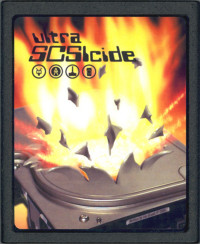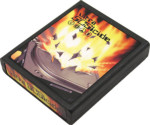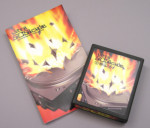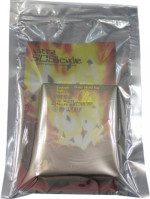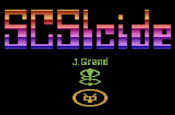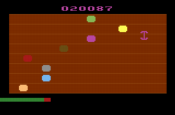SCSIcide is an original, fast-paced homebrew game released back in 2001 by Joe Grand of Pixels Past. In SCSIcide you play the role of a hard drive read head. As the different colored bits scroll by on the hard drive platter, you need to quickly read them in the correct order before you suffer a buffer underflow. As you complete each level, the data scrolls by more and more quickly! How far can you go? If you're a fan of Activision's Kaboom!, then you'll love SCSIcide.
Joe Grand has spent some time recently updating SCSIcide and has released a new version of the game titled Ultra SCSIcide. This latest version of the game contains many improvements over the original:
- Added support for joystick controllers. Controller type is automatically detected when you press the paddle or joystick fire button to start the game.
- Fixed the flicker that used to occur at the beginning of each level.
- Changed background and data bit color palette to make bits easier to distinguish.
- Reduced track size from 10 to 8 bits, for a more appropriate one byte per level.
- Changed speed increase per level - only two random data bits increase in speed each level.
- Modified the sound and scoring routines to account for longer gameplay and higher levels.
- Changed title screen text and added GIS and Pixels Past logos.
- Added a PAL version of the game.
If you'd like to more about SCSIcide's original development, be sure to visit Joe Grand's SCSIcide Development Log (you might want to read from the bottom up).
To help commemorate this new version of the game, Joe Grand and AtariAge teamed up to create a new label and manual for Ultra SCSIcide. To that end we held a Ultra SCSIcide Label Design Contest to create original label artwork that graces all copies of Ultra SCSIcide that are sold through the AtariAge Store. One of Nathan Strum's submissions was chosen as the winning label entry. This artwork is also featured on the cover of the manual.
Includes cartridge, 12 page, full-color manual, and anti-static bag in keeping with the hard drive theme of the game. Available in NTSC and PAL television formats, please specify above when ordering.
| Author | Joe Grand |
| Number of Players | 1 |
| Controller | Paddle or Joystick Controllers |
| Cartridge Size | 4K |
| Label Design | Nathan Strum |
| Manual Design | Tony Morse |
In the game you control a hard drive read head (no joke) and you scan back and forth across a spinning HD platter to read the bits of data in the correct order. How do you know the right order? Each bit is a different color and you have to match the changing read head color to the bit color. As the bit passes through the head you “read” the data by pressing the button, then it disappears. When all the bits are gone, the level is done and you start over with everything going a little faster.
It's definitely harder than Kaboom! since you're not just grabbing bombs, but discerning which color you need to acquire next and ASAP, since you lose points and your latency buffer decreases each time the bit passes by without being read. If the buffer runs out, game over. Being able to quickly and accurately discern the next color bit is imperative, and I think skill at rhythm games like DDR and Guitar Hero help. You'll need to stare at the entire board at once, never really concentrating on a single part of the screen.
That's really what makes the game so much fun and challenging. Most games allow you to concentrate on a small portion of the screen at any given time, but not here. You're best served by staring through the screen, never really focusing in, taking the playfield as a whole. With practice, you'll be able to get that Zen like stare where you're doing exactly what you need to do onscreen without really realizing it. There's something about the paddle controller that really lends itself well to these types of games.
My only complaint is the scoring system. It's sometimes hard to tell how well you're doing because you score is calculated in hex. Which basically means instead of rolling over after it gets to 9, it continues to f. So you end up with a score that's 2d0192 something. The first two numbers are the round you're in, followed by the score. It's interesting, and math geeks will probably love it, but for the rest of us it's just confusing.
Like the other homebrew games I've bought, this one comes with a full color label and manual. The game and the manual also come in a hard drive anti-static bag, which just makes the geek in me smile.
It’s an excellent take on Kaboom! and will challenge even expert players, and it’s an excellent addition to any Atari collection.
[adapted from review @ www.thebbps.com]

